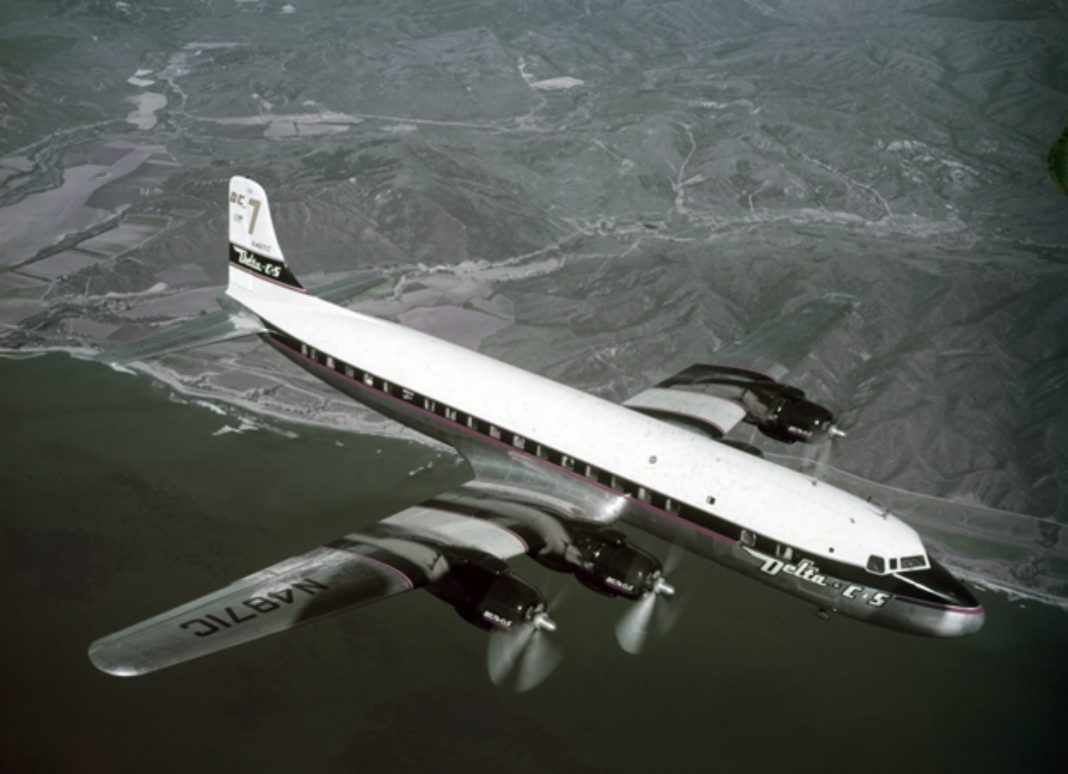Delta Air Lines flew several propeller aircraft, all of which helped the airline on its way to become a powerhouse within the aviation industry. The last of the Atlanta-based carrier’s Douglas propellers was the DC-7. Let’s take a look at the plane’s journey with the company before jet engines took the world by storm.

Natural progression
The Delta Flight Museum highlights that the DC-7 was the last piston-engine aircraft ordered by Delta. The airline took on the plane for its notable upgrade over the DC-6 and Lockheed Constellation. There were better capabilities when it came to speed, range and load capacity.
The plane could reach speeds or 3565 miles per hour and had a range of over 3,000 miles. It also had a capacity of 69 passengers. However, four of the airline’s DC-7Bs had an all-coach setup for 90 passengers.

A grand affair
A press release seen by Simple Flying shows how much of it big occasion the arrival of the DC-7 was. The fist arrival was given the nickname of Royal Biscayne and it was christened by movie star Piper Laurie on February 22nd, 1954.
Two days later the plane made way to Jacksonville from Santa Monica in six hours at an average speed of 371 miles per hour. The captain of the inaugural flight was C.H. “Charlie” Dolson, Delta’s vice president – flight operations. The pilot would also become the company’s second CEO in 1966 after the passing of C.E Woolman.

Nonetheless, the initial operations were based on a route between Chicago and Miami, which began on April 1st. The direct flight was three hours and 40 minutes. This duration was an improvement over the four hours that the DC-6 took. Service soon expanded southbound between Chicago, Cincinnati, Atlanta and Miami. Northbound operations were between Miami, Atlanta, and Chicago. Later that summer, the plane could be seen on routes from Chicago to Houston and St. Louis.
The plane would soon be deployed across Caribbean waters. For instance, it would fly to San Juan and Caracas from New Orleans. Altogether, by 1958, Delta’ the type served 18 major airports and formed 53% of all the airline’s seat miles flown. Subsequently, transcontinental operations began in the 1960s.

Well suited
Delta was notably impressed with the better specifications that the DC-7 had compared with its predecessor. There was plenty of potential to had with the plane across the carrier’s services.
“The fuselage is longer than the DC-6 by 14 seats; measures 108’11” against the DC-6’s 101’6”. The wing span is the same – 117’6”. The seven has a gross weight of 116,800 pounds and a cargo compartment capacity of 12,180 pounds. Upper and lower cargo compartments afford stowage facility for baggage and cargo. One of two leading doors located along the lower right side of the fuselage opens directly into the lower forward cargo compartment; the other opens into the aft cargo compartment” Delta said in the press release that was shared by the Delta Flight Museum.
“The main cabin, flight compartment, and lower fuselage compartments are pressurised and heated or cooled by an air conditioning system that can be operated either automatically or manually. For added passenger comfort a bulit-in Freon refrigeration system is installed in the air conditioning system to cool the plane during ground stops and for low altitude flights during hot weather.”

Going out in style
The airline launched exciting promotions with the arrival of the DC-7. The Crown Service, which was introduced in 1954 and saw the placement of extra onboard amenities such as typewriters and electric shavers.

Additionally, the Royal Service, which was put into place from the fall of 1958 saw complimentary champagne om board served by three flight attendants instead of the standard two. There was also a selection of of entrées at mealtime, and canapés and cocktails in the afternoon. Other amenities also included special check-in and priority boarding.
The DC-7 was a compelling aircraft. However, it quickly became overshadowed by the arrival of the jet age. Just five years after introducing the DC-7 propeller, Delta would fly its first jet aircraft.
Appropriately, Delta would take on the DC-8, continuing its trend of operating Douglas’ famous series. However, the deployment of this plane would mark the beginning of the end for Delta’s relationship with propeller aircraft. The airline began offloading its DC-7 aircraft in 1966 and in the following year it retired all but four aircraft of its DC-7s. Subsequently, by February 1968, Delta was no longer flying the type.
Altogether, the DC-7 flew for 604,623 hours and 24 minutes with Delta. This figure marks a busy 14 years for the aircraft.
What are your thoughts about the Delta Air. Lines Douglas DC-7 aircraft? Would you have liked to fly on this plane? Let us know what you think of the type in the comment section.
[ad_2]
Source link


